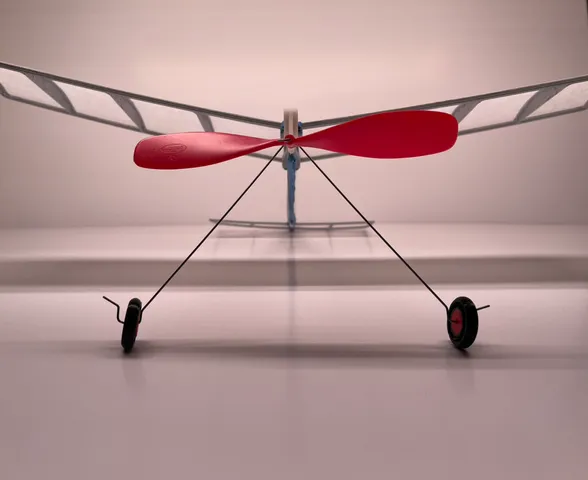
Free Flight Airplane
prusaprinters
I have been flying RC models and printing airplane models for years. Designing a flying machine can be tricky. Should I enroll in a proper fluid mechanics? Not yet, I took the challenge to retrofit an existing balsa wood airplane model as a starting point and do the required modifications to make it fly. For this project, I designed and built from scratch a model that I adapted specifically for 3D printers using light weight PLA and a more impact resistant filament material. The total printed model including motor (rubber band) weight is less than 19 grams. The original balsa wood model Minnow R.O.G. (Rise of Ground) was designed by Lloyd Shales and engineered by Rolly Simonsen. This wood model Free Flight Airplane has been used as an educational construction subject, teaching science classes in their Aeronautic education and also other groups.Watch the building steps and tips in this video List of materialMusic wire 0.031" (0,8 mm)dia. for DYI propeller shaft and rear motor.or 0.042"dia x 2 ½ " prop shaft (2x) (Guillow's)Music wire 0.020"(0,5 mm) dia. for landing gear. * rev. 2023-03-20Graphlite carbon rod 0.070" (1,8 mm) for fuselage1,8 dia. x 272 mm (1x) lower fuselage1,8 dia. x 68 mm (1x) upper fuselage under wing1,8 dia. x 20 mm (4x) upper fuselage under wing for rubber band1,8 dia. x 40 mm (1x) fuselage tailWhite tissue for wing and stabilizers ( Guillow's)Tissue Paste ( I used the one made by Deluxe Materials (UK))5"(127 mm) dia. propeller ( Guillow's), 5 ½ " (other option 140 mm dia.)Rubber band 9" loop x 3/32" ( Guillow's) for motor, (I used 7" loop.)Rubber band 1 x 60 mm (Horizontal Stabilizer)Rubber band 3 x 70 mm (Wing)Socket Head Cap Screws 3 dia. x 12 mm long for wire gaugeM3 hexagon nut for wire gaugeCA gluePolyLight1.0 (LW-PLA) & PolyAir1.0 from 3DLabPrint.Note:If you are not planning to use LW-PLA, your plane will be too heavy and will not fly.If you have in mind to build only a static plane only for display, keep in mind the fuselage parts MUST be printed in vase mode. I preferred to build my own propeller shaft and rear hook. Its more compact and a bit lighter.Each gram count!Propeller Assembly DetailsDrill 1,0 mm thru if using DIY 0,8 dia.mm prop shafts.Drill 1,2 mm thru if using Guillow's 1.05 dia.mm prop shafts. Hold plier and bend wire 90 degrees and then cut excess wire.Rear Motor Mount DetailsDrill 1,0 mm for rear shaft hookDrill 1,8 mm for fuselage carbon rod.Rear shaft hook has to be bend 90 degrees and cut. It has to clear larger hole.CA glue will have to be added between fuselage parts and on rear motor mount.Installing carbon rods on Fuselage partsNote: Chamfer all carbons rods ends with sand paper before installation.If possible, don't apply CA glue between carbon rods and fuselage parts. If needed you can reuse the carbon rods. Push slowly the 1,8 dia. x 20 mm carbon rods in the upper section. (4x).Push slowly the 1,8 dia. x 68 mm carbon rod as shown. (4x) thru fuselage A & B.Push slowly the 1,8 dia. x 272 mm carbon rod as shown thru fuselage A,B,C and D.There is a visual triangle opening in the fuselage tail ( D) to make sure the long carbon rod has reached the end. The last carbon rod 1,8 dia. x 40 mm is insert in the tail. Keep 5mm out. You MUST only apply CA glue to the fuselage D to the surface shown in red to fix the Horizontal Stabilizer. The rubber band will fix the other end. If you glue all the way there would be no pitch adjustment .Notes before flying your Minnow R.O.GIt is recommended to lubricate the motor rubber band for better performance and longer life.Do a test flight slightly straight out, adjust the landing gear and horizontal stabilizer angle to get a nice straight long glide. no other weight should be necessary, but if you need, add some plasticine.Wind up about 200 turns and let it fly out of your hands. if it flies with a slight climb, try another 100 turns to a max of 400 turns.When building with a group, simple duration contests are great way to put a successful end to the session.A special Thanks to Cato Hansen for his write-up about the original balsa wood model.Good luck, enjoy your build and have fun!
With this file you will be able to print Free Flight Airplane with your 3D printer. Click on the button and save the file on your computer to work, edit or customize your design. You can also find more 3D designs for printers on Free Flight Airplane.
